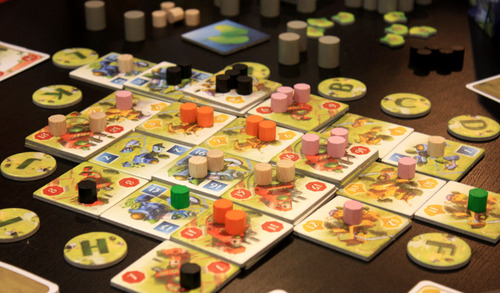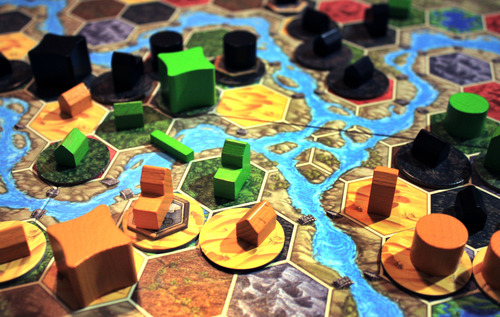
Ginkogopolis was fun the first few times I played it, but eventually I found the novelty to wear off. For those unfamiliar, Ginkgopolis is ostensibly a game where you are building a futuristic city, but realistically it is a sort of area-control tile-laying game – except it also incorporates drafting cards (in order to lay the tiles to build the city), resource management (as you need to generate the thingies you need to build the tiles – plus the tiles themselves – plus victory points, which are a resource in and of themselves) and palette building (because as the game progresses and you build higher towers, you will get more abilities and need to strategically synergize the abilities you get by building the appropriate towers). If this all sounds complex, that’s because it is complex – I find it generally takes even veteran board gamers at least one play to get used to the rules, but once you do, the rules design is actually quite masterful and elegant (really, it’s quite a triumph for so many mechanics to flow together so seamlessly).
That having been said – I’m not that wild about it. It’s okay with three players and gets worse with four and five. Why don’t I like it that much, you might ask. Well, it’s an area-control tile layer like Carcassonne is, but where Carcassonne spreads out over an entire table, games of Ginkgopolis tend to build upwards and be extremely vicious (since you are therefore building over each other’s tiles a lot). “But Chris,” you say, “you like vicious games.” True, but I like them to be strategic, and due to the way the rules work and the game generally plays, this is far more a tactical game of “what is the best play available to me on my turn” than anything to do with long-term planning, because the game’s design actively prevents you from planning long term: often you will find yourself simply picking the least worst option on multiple turns, which makes the game feel as though it is particularly luck-driven. This is because the game is particularly luck-driven. So is Carcassonne, of course – any turn-taking tile-layer will have a luck element to it – but Carcassonne’s design means you can always go start something else in an effort to score points. In Ginkgopolis, that option is not really present to you. Worse, in Ginkgopolis, some of the upgrade cards you can get over the course of the game are just plain better than others (tower-building cards are better than outward-expansion cards, generally, because towers are less easy to build over), which makes the game feel even more luck-driven.
I don’t mean to trash the game overly. As I said: the design is very clever indeed, and frankly, it’s only a 45-minute game or so once everybody knows how the rules work so it being luck-driven is hardly a killer factor. But my weakness for boardgaming is city building games – I desperately want the “Sim City in a box” experience (where you have to worry about taxation, and the environment, and keeping citizens happy), and I buy every city-building game that comes out, and invariably they disappoint. (I may just have to design that game myself.) So Ginkgopolis gets graded on a curve, which might not be entirely fair, but who said life was fair?

I had been looking forward to CO2 for over a year. It had so much going for it! Designed by Vital Lacerda, who did the excellent Vinhos (one of my favorites of 2011), and with a killer theme – you’re trying to build renewable energies to stop global warming from annihilating the planet. (As a side bonus, the game’s theme caused an immense amount of butthurt to conservative board gamers who took the game’s existence as a personal insult, to which I can only say HA HA HA HA HA.) I was totally expecting a home run here.
And… yeah, no. The game is complex – not killer complex, but complex enough that there are strategies, obviously. And Lacerda’s clearly tried to incorporate the theme into the mechanics in many ways (ramping energy demands as time progresses means that if you don’t build renewable energy plants fast enough, countries will just build fossil fuel plants to meet demand instead, for example). And the board itself is honestly just lovely to look at. But the problem with the game, for me, is that the core mechanic doesn’t really feel right. The core mechanic in this game is a three-step process: on your turn you either start a energy plant research project, convert a research project into a pilot energy plant, or convert a pilot plant into a full-on power plant. Except you can convert other people’s things. Which from a game standpoint is necessary because otherwise the game doesn’t work, but thematically it doesn’t really make sense and from a gameplay standpoint it just feels so arbitrary that it kills the mood – and this is the opinion of everyone I’ve played the game with. Which is a damn shame, because I really wanted this one to be good.

I got the chance to play Terra Mystica a few weeks ago and then again last week. This was the critical darling of the Essen game fair this year, so I was interested to give it a go. And… it’s not bad, certainly. It’s basically a riff on the sort of area control you might find in Through the Desert, where you place pieces on the board and then control those areas forever. Terra Mystica is a lot more elaborate, though – each player has a different fantasy race with different powers that affect the game differently, and each player gets, like, inns and castles and monasteries and all that sort of thing, and everybody’s castles and inns and monasteries do different things, and there’s a sort of power meter which you can use for additional free actions, and…
Terra Mystica isn’t a bad game – far from it. It’s quite a pleasant brainburner, and the game is perfectly solid. But after playing it twice, while I would play it again without complaint if people wanted to play it, I feel no need to own it or suggest it be played ever again – because, really, it’s just Through The Desert with more bells and whistles (and fewer camels), and in this case I think the simpler game is the better experience because Terra Mystica’s challenge is mastering the logistics of your own species faster than other players to get your pieces on the board, while Through The Desert’s challenge is getting in other people’s way with your pieces which you just PUT on the board. And I prefer that second one.


Related Articles
5 users responded in this post
One question, since you’re a board game crazy person like I am and most of my friends are.
Do you find that the suggested playtime on the box is generally nowhere near the actual playtime when you get a group of dedicated gamers into it? When there’s a window for ‘big strategy’ to be taking place, do you find it taking awhile as players try to project through their next, and next, and next turns?
“…you like vicious games…”
I would greatly enjoy a list of games that have a vicious feel to them! (Especially if it isn’t too luck-based, where only one person gets to give someone the Queen of Spades.)
I’ve played Terra Mystica probably closer to ten times, and for me the appeal is the variable player powers. I see it as less about blocking other people’s expansion and more about building an engine, and every race’s engine is different. I mean, while they’re both area control, TTD’s a bit more take-that while TM’s more inwardly focused.
Totally agree on CO2. Fantastic visual design (except for a few places where colors aren’t distinct for different things), interesting interlocking systems, totally falls apart because someone can (with no malice) pre-empt a vital part of your engine.
@Christian Williams: That is less a function of the game and more a function of the players. Some people suffer analysis paralysis, taking forever every turn to churn through the possibilities. Some people play by intuition. Some people play a game often enough that they develop a routine that requires few pauses. Some people do as much planning as they can during other players’ turns as they can and only need to pause when something upsets the equilibrium drastically.
Have you tried Suburbia yet? I got a chance to play it a while back and really liked it, and it’s definitely got a Sim City feel to it.
I actually just played Suburbia last night and I liked it a whole lot. It doesn’t do everything I want my dream city-building game to do, certainly, but it comes closer than any game has yet.